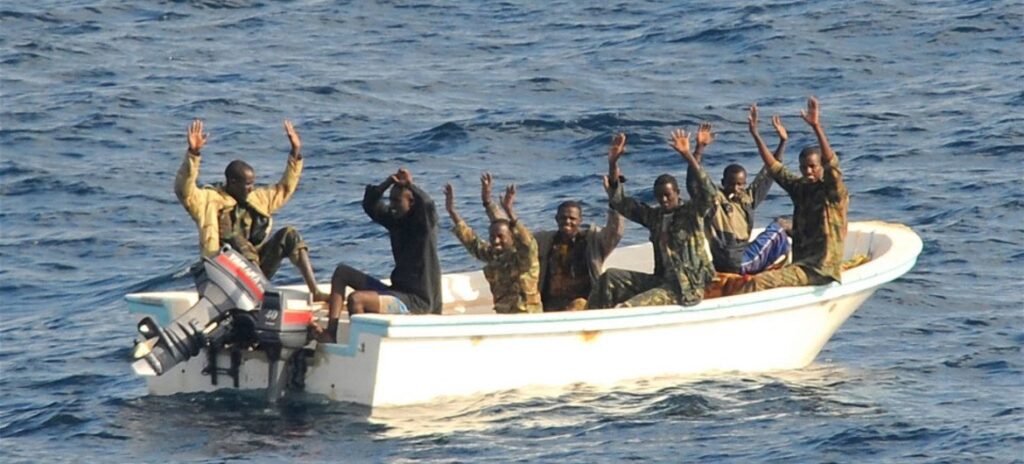After more than a decade of relative calm, Somali piracy off the coast of Somalia is once again threatening vital international shipping routes.
Highlighting the fragility of past gains and the need for renewed global and local action.
Somali Piracy Returns
In recent months, dozens of hijackings have been reported, with Somali pirates holding multiple vessels hostage for ransom.
The situation reached new heights when, on September 25, a Somali pirate group hijacked the MV Faina, a Ukrainian cargo ship carrying 30 Russian T-72 tanks and other weapons.
The incident triggered an international standoff, with American and Russian naval ships now surrounding the vessel.
While the scene sounds like a page out of a Hollywood script, the consequences are deadly serious—not just for ship crews, but for Somalia’s stability and the global economy.
A Dangerous Comeback: What’s Fueling Somali Piracy Again?
Despite earlier success in suppressing piracy through coordinated international naval patrols and local enforcement, the root causes of piracy in Somalia have not been resolved.
That’s why the threat is now re-emerging, these causes include:
- Weak maritime law enforcement
- Unpoliced territorial waters
- Rampant poverty and youth unemployment
- Corruption and absence of legal accountability
- Organized criminal networks benefiting from ransom payments
These conditions allow pirates to operate with relative ease, often disguising themselves as fishermen before launching their attacks.
Why Somali Piracy Poses a Global Risk
The Horn of Africa is one of the world’s busiest maritime corridors, linking Europe, Asia, and the Middle East.
Renewed Somali piracy activity disrupts:
- Global supply chains
- Maritime insurance premiums
- Humanitarian aid delivery, especially to Somalia and neighboring states
- Foreign investment and international confidence in Somalia’s recovery
Moreover, Somali piracy injects illicit cash into the local economy, which—according to UN Security Council Resolution 2608—fuels crime, terrorism, and corruption.
The International Response: UN Resolution 2608 and Beyond
To tackle the return of Somali piracy, the UN Security Council adopted Resolution 2608, reaffirming global commitment to suppressing maritime crime.
The resolution emphasizes:
- Condemnation of Somali piracy and armed robbery at sea
- Legal accountability for those organizing, funding, or profiting from pirate activity
- Support for Somali authorities to patrol territorial waters and recover seized assets
- Urging member states to criminalize piracy in their domestic laws
- Strengthening maritime security capacity through cooperation with Somali authorities
- Continued naval deployments and international coordination
The resolution also encourages Somalia to join the UN Convention against Transnational Organized Crime and build a legal framework to prosecute money laundering and piracy-related financial networks.
Read also: Puntland and the Federal Government Conflict Enters A New Phase in 2025
Real Solutions: What Needs to Happen Next
To stop Somali piracy from becoming a full-blown crisis again, a multi-pronged approach is necessary. Here’s what can work:
1. Strengthen Somali Maritime Forces
Somalia must build its coast guard and maritime policing capabilities, with international training and funding.
Patrolling territorial waters consistently is crucial to deterring pirate activity.
2. Establish Functional Legal Frameworks
The Somali government should finalize maritime laws, criminalize piracy domestically, and create mechanisms for fair and timely prosecution of pirates.
Including those funding or facilitating operations inland.
3. Target Pirate Financing and Money Laundering
Cutting off the financial lifelines that support piracy is essential.
This includes targeting local criminal networks, corrupt officials, and offshore banking systems that facilitate ransom payments.
4. Create Alternative Livelihoods for Coastal Youth
Poverty, unemployment, and lack of opportunity continue to push Somali youth toward piracy. Development programs offering skills training, jobs in fishing, agriculture, and port services can offer a viable alternative.
5. Maintain and Modernize International Naval Presence
Continued deployment of naval patrols by international coalitions.
Especially around high-risk areas—can prevent attacks before they happen and intercept pirates en route to targets.
6. Improve Coordination Between Agencies
Better collaboration among the UN, IMO, WFP, Somali government, shipping industry, and regional security forces can lead to more responsive and effective anti-piracy strategies.
7. Public-Private Cooperation on Vessel Security
The International Maritime Organization (IMO) recommends arming cargo ships with privately contracted security personnel when traveling through high-risk areas.
This approach remains a proven deterrent.
A Cautionary Tale—and a Call to Action
The hijacking of MV Faina isn’t just an international incident—it’s a stark reminder that piracy thrives in the absence of governance, justice, and opportunity.
The return of piracy off the Somali coast represents a broader failure to address the systemic issues driving maritime crime.
However, it also presents a renewed opportunity.
With coordinated international action, strong leadership from Somalia, and sustained support for legal reform and capacity building, piracy can once again be brought under control—and this time, for good.
Conclusion:
Piracy off the coast of Somalia is not just a maritime issue—it’s a national security, economic, and governance challenge. The resurgence of hijackings, ransom demands, and criminal networks underscores the urgent need for long-term, collaborative solutions. With international will and domestic reform, Somalia can close this chapter of lawlessness and secure its waters—and future.


